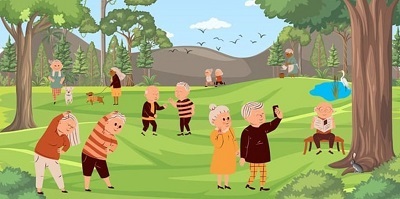Life Rights - Part Four in a series of 'Life Rights' articles written by Prof Graham Paddock
Here is Part Four in the series of 'Life Rights' articles written by Prof Graham Paddock.
CLICK HERE for part 1 of this 5 part series
CLICK HERE for part 2 of this 5 part series
CLICK HERE for part 3 of this 5 part series
UNDERSTANDING LIFE RIGHTS: What happens in practice
Article by Graham Paddock

Introduction: In practice, the management provisions of both the Housing Development Schemes for Retired Persons Act of 1988 ('the Act') and the Sectional Titles Schemes Management Act of 2011 ('STSMA') do apply to many developments. These are 'hybrid' developments in the sense that they include both life right holders with unregistered statutory rights under the Act and sectional title owners with registered title to units. Such hybrid setups can emerge in scenarios such as when:
- retirees acquire life rights before a developer opens a sectional title register for the property, but when this occurs units are not transferred to the life right holders because they have no right to claim transfer, or
- units in an existing sectional titles scheme with different owners are made subject to life rights.
The situation where a development is regulated by both a life rights management association ('LRMA') established under the Act's regulation 7 and a sectional titles body corporate ('STBC') established under section 2(1) of STSMA is not dealt with in any statute. So in these situations the challenge is to understand what part each statutory body is entitled and obliged to play in the scheme's administration.
Additional complexity: A hybrid scheme may be even more complicated when:
- There are linked non- and for-profit stakeholders:
Many retirement schemes include for-profit businesses open to the public, as well as the nonprofit LRMA. These for-profit businesses provide a variety of services required by retirees, including management, healthcare, gardening, food and beverages, repairs and maintenance, security, power, connectivity, social and recreational services. The retirees may, in some cases, be entitled to choose alternative service providers, but in many cases they are 'captive consumers' meaning they are contractually obliged to use the in-house service providers.
- Assignment of management duties and rule changes:
In many hybrid retirement schemes, the STBC's functions and powers are delegated to a common law association ('CLA'). This leads to varying rights allocations, necessitating close examination of any contractual arrangements to discern the underlying logic.
Provisions I have seen in CLA constitutions and life right management agreements allow the developer to:
- retain the right to appoint the managing agent and other service providers;
- control the common property that is subject to life rights, use it for profit, and allow the public to use it;
- retain predominant voting rights in the association's executive committee and general meetings, regardless of the number of life rights they hold, and
- unilaterally set the scheme's budgets and the contributions payable by life right holders.
It's essential to be vigilant about certain provisions sometimes found in CLA constitutions and life rights agreements which might not align with the Act's mandatory management regulations. Hybrid retirement schemes can be divided into categories based on their design, as follows:
Category 1: Single Purpose Property Entirely Subject to Life Rights
Description: In this category the entire property is occupied by life right holders and operated for their benefit.
Management:
- The LRMA: This statutory body manages the entire property in terms of the Act's management regulations on behalf of the life right holders.
- The STBC: This statutory body deals with any sectional title registration decisions, as set out in section 5 of the STSMA, on behalf of the unit owners.
Category 2: Segmented Property with No Shared Facilities or Services
Description: This category involves parts of the property that are under life rights, while other parts are not. Crucially, the two segments do not share any facilities, infrastructure, or services. They operate independently of each other.
Management:
- Life Rights Segment: The LRMA oversees this segment's financial, administrative, and physical management.
- Non-Life Rights Segment: The STBC or CLA is responsible for administration of this segment.
- Sectional Title Registration Issues: Any registration issues related to sectional title in any of the segments are addressed by the STBC or CLA.
Category 3: Segmented Property with Shared Facilities or Services
Description: This category, like Category 2, involves parts of the property reserved for life rights and others that aren't. Crucially, both segments share certain facilities, infrastructure, or services, jointly accessing and benefiting from them.
Management:
- Life Rights Segment: The LRMA manages this segment, taking care of the financial, administrative, and physical aspects.
- Non-Life Rights Segment: This segment is managed by the STBC or CLA, similar to Category 2.
- Shared Facilities and Services: Both the LRMA and the STBC (or the CLA on its behalf) are jointly responsible for the administration, funding, and management of shared facilities/services. Their roles are defined based on an equitable agreement between them, ensuring that the shared spaces and services cater to all members effectively.
- Sectional Title Registration Issues: As with Category 2, the STBC addresses any sectional title registration issues in any segment.
In the forthcoming fifth part of this series, I'll examine a real-world case study illustrating the complexities of managing a Category 3 hybrid retirement scheme. This examination will provide insights into the intricate 'marriage' between the Act and STSMA, as well as recommended strategies for life right holders who confront potentially prejudicial provisions.
Courtesy: Graham Paddock

Graham Paddock is a specialist community schemes attorney, notary and conveyancer. He has been advising clients and teaching students for over 40 years, and was an adjunct professor at UCT for 10 years.
Article reference: Paddocks Press: Volume 18, Issue 20.
This article is published under the Creative Commons Attribution license.


